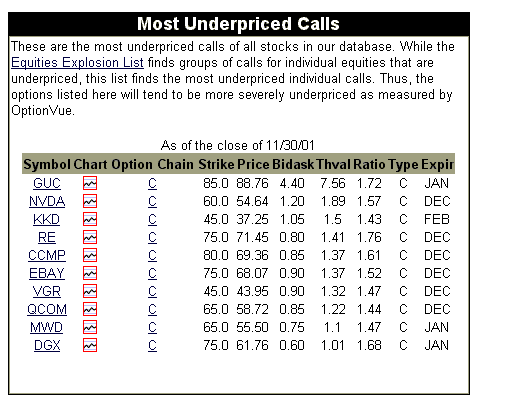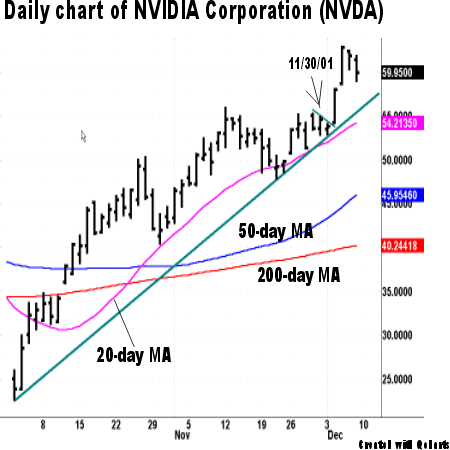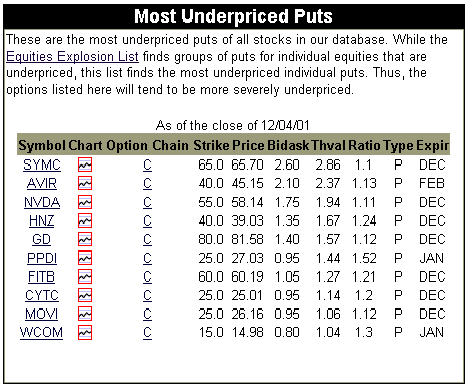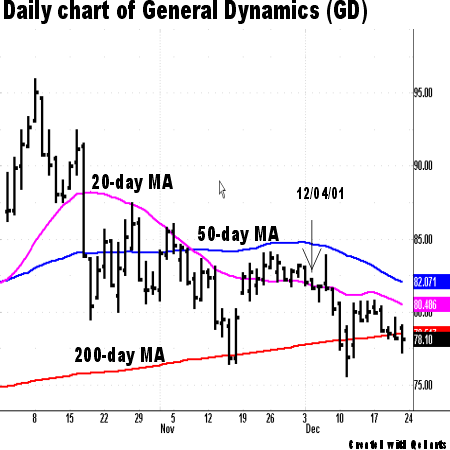How To Use TM’s Indicators: The Most Underpriced/Overpriced Puts and Calls
Using our proprietary formulas, each night we scan for calls and puts that show the biggest discrepancies between market price relative to theoretical value. What makes an option’s price different from its theoretical value is a component of its price known as volatility. It is volatility — or more specifically, implied volatility — that will tell you whether an option is cheap or expensive. In this lesson, we will show you how to use TradingMarkets’ lists of Most Underpriced Calls, Most Underpriced Puts, Most Overpriced Calls and Most Overpriced Puts.
When the market price of a call or put option is less than its theoretical value, we say that the option is under-valued, or cheap. Whereas if the market price is greater than the theoretical value, we say that the option is over-valued, or expensive. The theoretical price and the market price will often differ, as this can be due to the market’s estimate of volatility, compared to historical volatility. Be forewarned, however: Just because an option is under-priced does not mean that it will automatically go back to its theoretical value. Therefore, you should not rush out and buy it. Likewise, if an option is over-priced, you should not just blindly sell it. Doing so could end up costing you dearly.
How much you pay for an option is very important. Ask yourself how many times you have bought an option, had the underlying move decisively in your favor, but when you looked at your option, it had barely budged? Or how many times you have sold an option and felt that you received too little of the premium? Chances are, those options were either over- or under-valued to start with. Option trading in itself is a difficult task as, unlike stock, you only have to worry about the stock going up or down. With options, you have other factors affect price. So, buying under-valued and selling over-valued options will put you at an advantage.
How can you take advantage of these under- or over-priced options? There is no one way to trade these options. However, the basic idea is always going to be buying the under-valued and selling the over-valued option. By doing so, you capture a theoretical edge. Different traders will trade options differently. Some will only do outright purchases or sales, while others will trade spreads and combos. Due to the versatility of options, the strategies that you could employ will mainly depend on:
- Your risk level
- Your knowledge and understanding of options
- Your opinion on the stock
We will show you several ways in which you can use these options:
- As a stock substitute with a technical setup
- In conjunction with stock
- In spreads to take advantage of reversion to the mean
The easiest way to use these lists is to use options in place of stocks when you have a directional opinion on a stock. Keep in mind that an option is not a direct substitute for a stock and will exhibit different characteristics. By using options, you’ll increase your leverage and limit your losses, in case there is an adverse move in the opposite direction. You’ll also have the advantage of buying a theoretically cheap option, which will give you an extra edge and improve your probability of profit. We suggest you only purchase under-priced options and not sell naked over-priced options which expose you to unlimited risk. Let’s go through an example. On Friday, Nov. 30, Nvidia Corporation
(
NVDA |
Quote |
Chart |
News |
PowerRating) appeared on our Most Underpriced Calls list.

The previous day it was announced that NVIDIA
(
NVDA |
Quote |
Chart |
News |
PowerRating), a strongly trending and high relative strength stock, would be added to the S&P 500, replacing Enron
(
ENE |
Quote |
Chart |
News |
PowerRating). This, of course, is bullish news which adds fuel to the fire, since all S&P 500 index fund managers would have to buy the stock. With the out-of-the-money NVIDIA Dec. 60 calls being shown as undervalued, you could have bought the call in anticipation of a rise in the stock price. Since the Dec. 60 calls have only three weeks until expiration, this was a very speculative trade that will require a quick, large move in the stock.

On Monday, Dec. 3, NVIDIA gaps down at the open, but finds support at its rising trendline. The Dec. 60 calls open at 0.80 and close at .85. The next day, the stock gaps up and trades over 4 points higher for the day. The Dec. 60 call open at 1 and close at 2.20, more than doubling in price. The following day (12/05/01) the stock runs up another 4 points and the Dec. 60 calls run up to 4.80!
Depending on your view of the stock, along with your options knowledge and risk level, there are other ways you could have used the under-priced option.
First, if you are some what risk-averse and did not want to put that much money at risk, especially on a short-term trade, you could have turned the trade into a directional spread strategy, such as a bull or bear spread. In this case, since you were bullish, you could have turned the trade into a bull spread by buying a lower strike call and selling a higher strike call. Since the Dec. 60 calls are under-priced, you would buy the Dec. 60 and sell a higher strike call simultaneously. Usually, the call option(s) sold will be one or two strike prices out-of-the-money. So depending on your outlook, you could have sold the Dec. 65 or 70 calls. What this does is lower your risk or initial cash outlay. However, you would have also put a cap on your return.

Likewise, if you were bearish, you could look to purchase under-priced puts. On Dec. 4, the General Dynamics Dec. 80 put showed up on our under-valued puts list. Looking at the chart, we see that General Dynamics
(
GD |
Quote |
Chart |
News |
PowerRating) was in a good downtrend and was coming out of a pullback from lows. Once again, you could have simply bought the Dec. 80 put in anticipation of a down move in the stock. On Dec. 5, you could have bought the Dec. 80 put at the open at 1.70. Four days later, the stock fell and the put went as high as 4.10.

Just as with the example involving the under-priced calls, if you were not comfortable with the level of risk, you could have turned the trade into a bear put spread. Thus, you would have purchased a put with a higher strike and sold a put with a lower strike price. In this case, you could have bought the Dec. 80 put and sold the Dec. 75 or 70 put. Once again, this lowers your initial cash outlay, but caps your profit potential.
The second way to use these options would be to use them in conjunction with stock you already own, as in such strategies as Covered Calls, Protective Puts and Protective Calls.
If you are already holding stock, but think that the issue will go up just a little or stay still, you can use our over-priced calls list to look for possible Covered Call opportunities. That way, you can be sure that you receive as much premium as possible for the call(s) that you sell.
Traders/investors will commonly purchase put options on their long stock positions, to prevent any adverse downside moves although of course that protection comes at a cost. You could use our Most Underpriced Puts list to give you protection at a lower cost: For example, you are long Krispy Kreme stock
(
KKD |
Quote |
Chart |
News |
PowerRating) in which you have a 20-point gain. You are worried that the market is overbought and you want to protect your gains in the stock. You could always use a sell stop, but if the stock gaps down substantially, it could blow right past your stop, giving you a larger-than-expected loss. The other alternative would be to buy a put option. By using the put option with stock you own, you are setting a floor to how much the stock can fall.
Traders/investors with short stock positions can purchase call options to protect themselves against any adverse upside moves. By using our Most Underpriced Calls, list, you can get protection at a lower cost. If you are in a short stock position in which you think the stock will collapse, but you are worried that the stock will bounce up in the short term, you can always set a buy stop or you can buy a call for protection. With the buy stop, you run the risk of the stock gapping up and giving you larger-than-expected losses. However, you can use options for protection, especially when they are cheap. By purchasing a call with a short stock position, you are limiting your losses and protecting yourself against an adverse price move to the upside. No matter how high the stock goes, you can always use your call and cover your short position at the call’s strike price.
The last way to use these options that we will touch on in this lesson is using them in conjunction with other options in volatility spreads. When used in this manner, the positions will have little to no directional bias. Rather, they are looking for an increase or decrease in volatility. Hence, when options are under-priced, they are under-priced because volatility is low. And we want to buy when volatility is low so that we can participate when volatility reverts to its mean and goes back up.
Likewise, when volatility is high, we look at over-priced options so that we can participate when volatility reverts to its mean and heads lower. In order for these spreads to be volatility spreads, they need to be delta neutral. By being delta neutral, the position will have no preference for either direction. All the position requires is an increase or decrease in volatility. Therefore, these options could be used in strategies such as ratio spreads, backspreads, butterfly spreads and calendar spreads. However, explaining volatility spreads is beyond the scope of this lesson.
|
|
